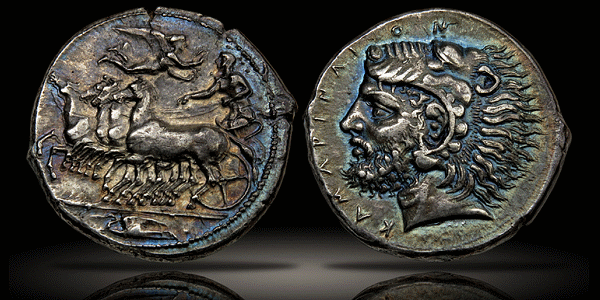The history of Kamarina, a port city on the southern coast of Sicily, is among the most tumultuous of Ancient Greece. It was founded in 599 BCE by settlers from Syracuse and its location allowed it to grow quickly and amass substantial wealth through trade.
However, within 40 years of its founding, Syracuse began to perceive it as a threat because of its success. The city was destroyed by Syracuse in 553 BCE and then re-founded by colonists from Gela, only to be destroyed again by Syracuse and re-founded for a third time by Gela in 461 BCE.
Even with Gela’s support, Kamarina was still weak, leading it to look for stronger allies to defend against future attacks from Syracuse. It sought out the support of Leontinoi until that city was destroyed by Syracuse in 422 BCE. It finally reached some semblance of stability through the protection of Athens, but Kamarina approached this alliance cautiously while waiting to see if Athens was indeed stronger than Syracuse.

Kamarinian tetradrachms around 425 BC
After producing only small-denomination greek coins during much of its existence, Kamarina finally began striking tetradrachms around 425 BCE and immediately produced a masterpiece. The obverse depicts a vivid example of the Syracuse galloping quadriga motif, with the reverse illustrating a powerful and mature head of Heracles wearing the skin of the Nemean lion.
The Heracles type was a reference to Kamarina’s Dorian origins and became extremely popular among Greek coinage, eventually serving as the prototype for the design chosen by Alexander the Great on his famous tetradrachms.
This issue continued until 405 BCE when Carthage attacked Kamarina and Gela, and the populations of both of these cities fled to Syracuse for protection under the power of the Greek tyrant Dionysios.
SICILY. Kamarina. Ca. 425-405 BCE. AR tetradrachm (26mm, 17.18 gm, 12h). Athena driving racing quadriga left; the quadriga with a broad, S-curved antyx (rim); Nike flying right above holding wreath to crown driver, heron flying left in exergue / καμαριναιον, bearded head of mature Heracles left, wearing skin of Nemean lion. Westermark-Jenkins 142 (same dies). Rizzo plate V, 9 (same dies). SNG-ANS 1203. SNG-Cop 162. Pozzi 398. Gulbenkian 174. With a powerful head of the Heracles in the finest style.



